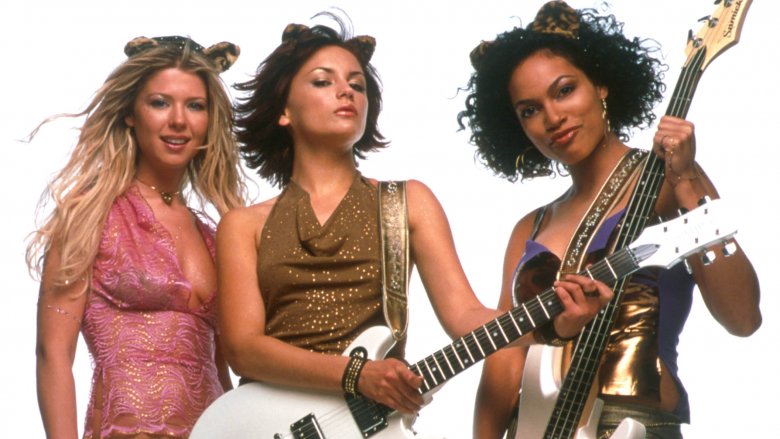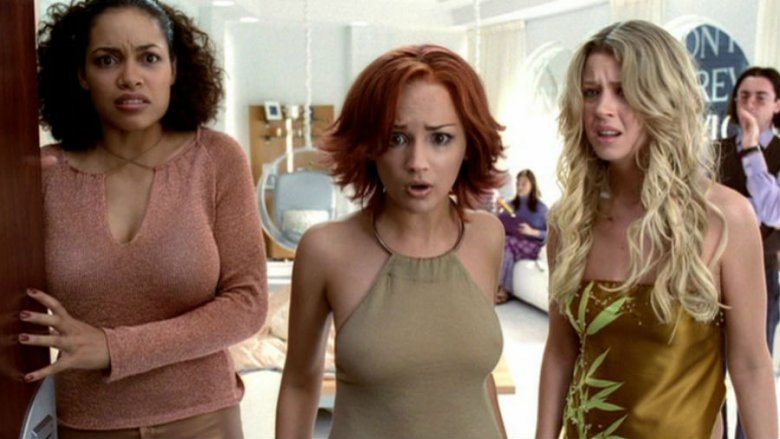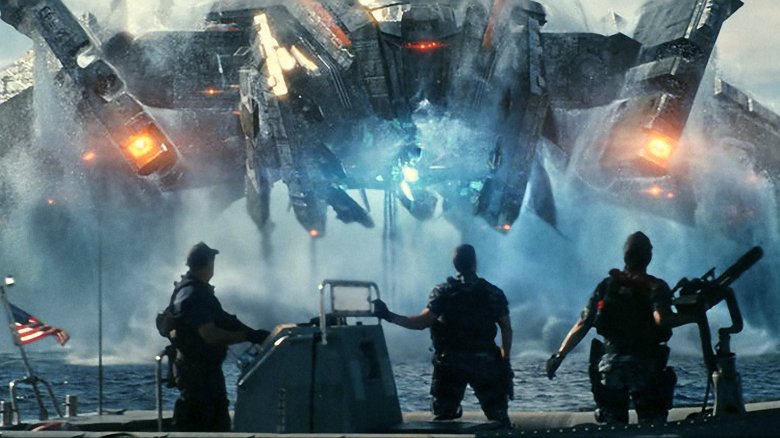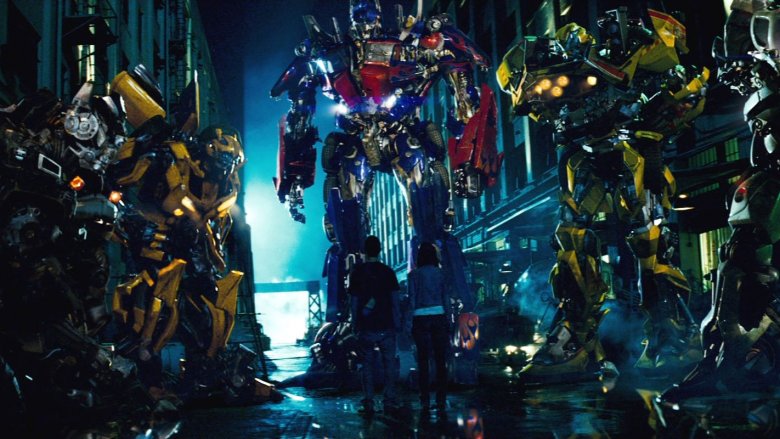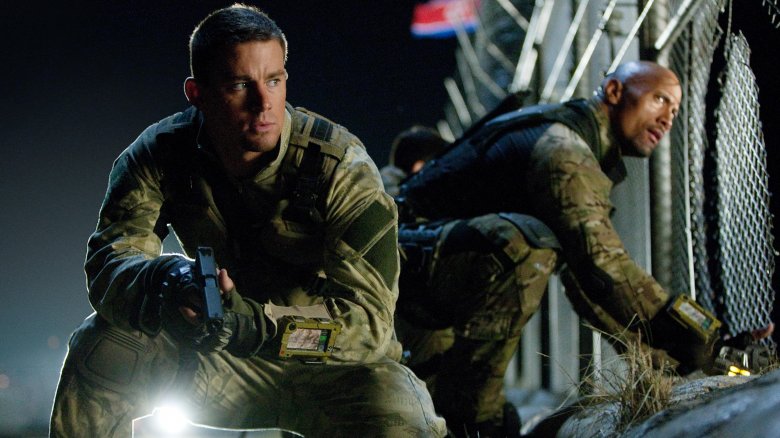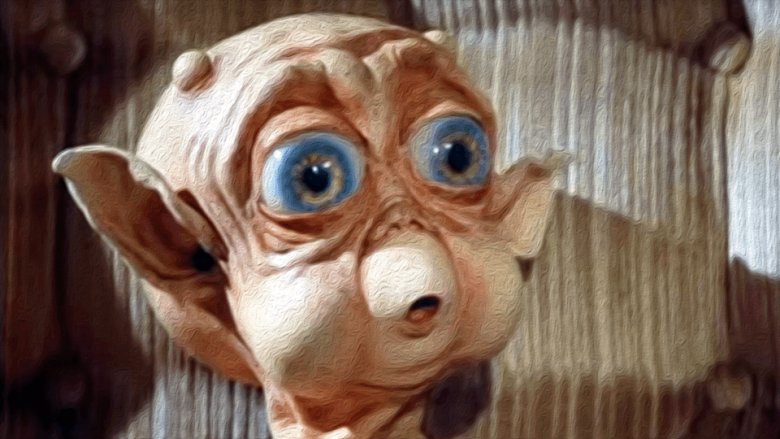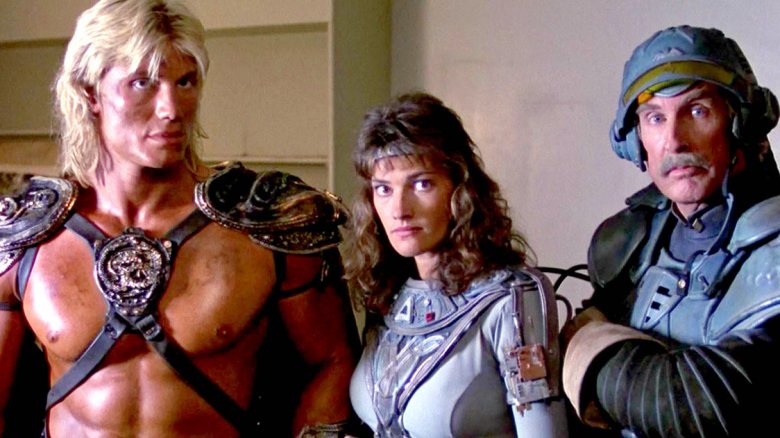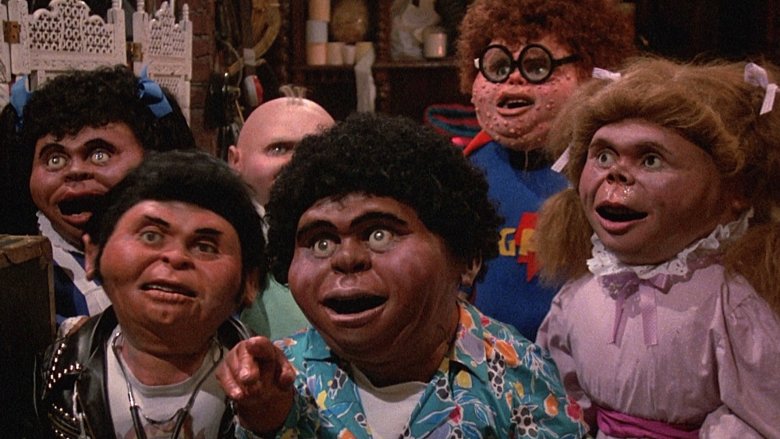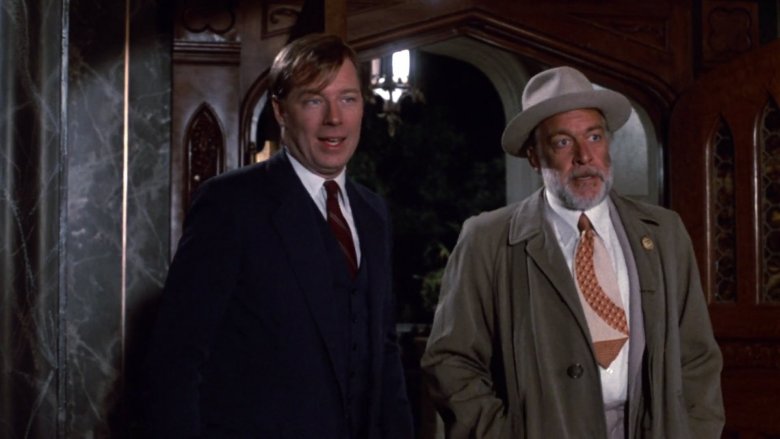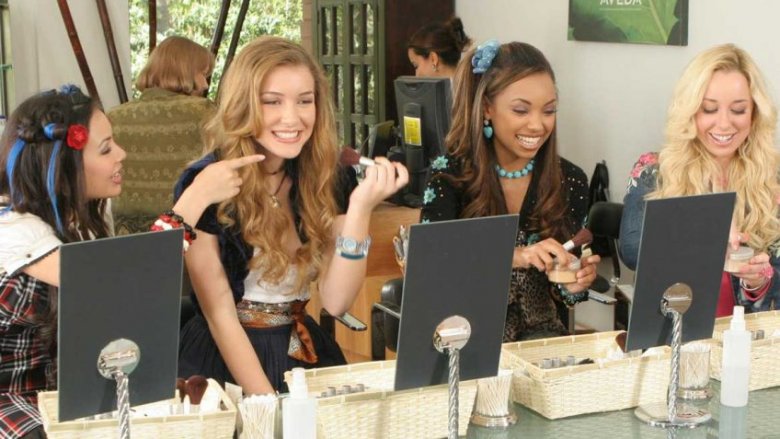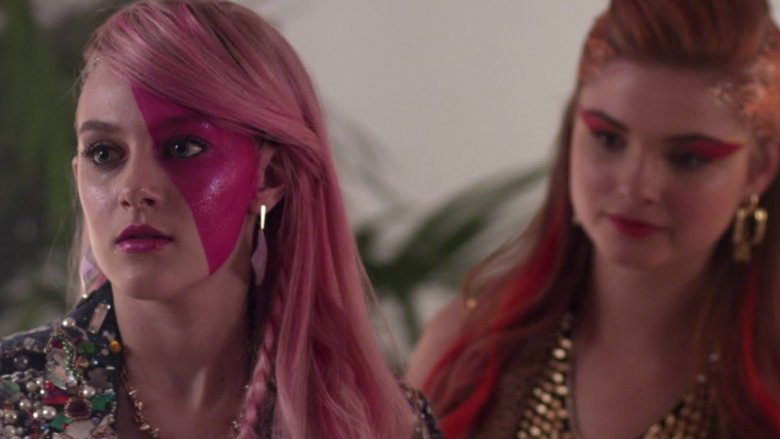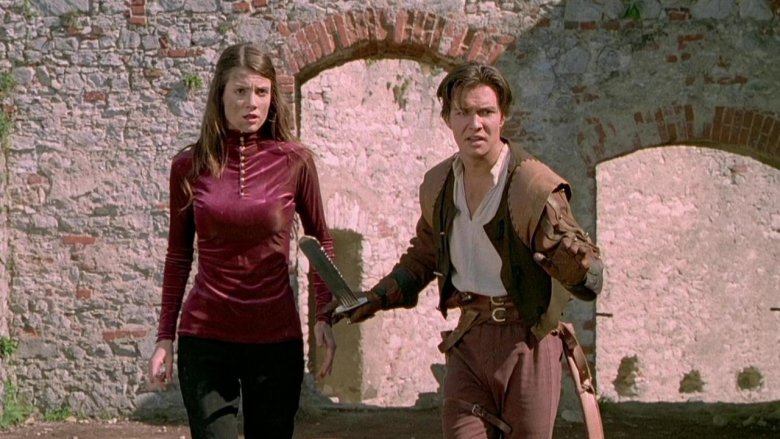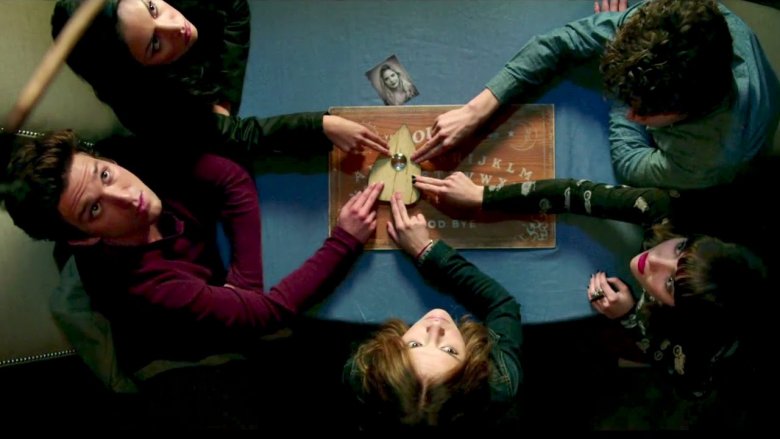Movies That Were Basically Just One Giant Ad
When you're watching television, you expect to still see ads, whether you're checking out a YouTube video, tuning into a network show, or catching your favorite movie on basic cable. Even in the age of streaming video and ad-free plans, commercials are still a necessary evil, and plenty of viewers are willing to sit through an ad for Swiffer or Google's newest phone to access the content they're looking for.
Most films these days feature a fair amount of product placement, whether audiences directly notice it or not. While films like Fight Club make fun of the idea of consumerism and product placement, others lean into it, like A Simple Favor's preference for Aviation Gin, Sex and the City's open display of designer brands, or The Internship focusing entirely on Google. However, the following films seem to only exist thanks to a previous toy, comic, or mythology, serving as one giant ad for something incredibly specific.
Josie & The Pussycats
In 2001, Harry Elfont and Deborah Kaplan took on the Josie & The Pussycats comics, serving up an entirely new spin on the classic Archie-adjacent series. With Rachael Leigh Cook, Tara Reid and Rosario Dawson as the main trio alongside brilliant supporting comedy players like Alan Cumming, Missi Pyle, Parker Posey, Breckin Meyer, and Donald Faison, the film painted a picture of a world where the recording industry exists solely to (literally) brainwash teenagers through pop music in order to sell them the newest consumer product, all of which is sponsored by the United States government. Though the movie bombed at the box office, critics have since re-discovered it, appreciating its clever take on capitalism.
As you might have guessed, the film is essentially one giant ad for every popular 2000s brand, including (but not limited to) Puma, Nike, Starbucks, Target, Aquafina, Revlon, Motorola, and more. Ultimately, this was the point — everything we see and watch is conditioning audiences to purchase new products, and this film is at once an indictment of this tactic as well as a perfect example, especially considering that the filmmakers voluntarily inserted every instance of product placement. Even if you leave Josie & The Pussycats wanting a six-pack of Zima and pink shoes, you'll still get the message that subliminal advertising is everywhere, and consumers should be cautious before they hand over their credit card.
Battleship
In 2012, Hollywood determined that the world needed a movie based on the board game Battleship, starring big names like Liam Neeson, Taylor Kitsch (Friday Night Lights), and Alexander Skarsgard (True Blood, Big Little Lies) alongside models and musicians like Brooklyn Decker and Rihanna. The stars implausibly played a group of soldiers and naval officers who have to defend their fleet against an incoming alien horde, and between the complicated plot and flimsy foundation, the film did not seem destined to be a hit. With a budget of $209 million, Battleship barely fulfilled expectations, and critics weren't fans either, though it was among the more successful films produced by Hasbro, particularly outside North America. In 2013, it was nominated for several Golden Raspberry Awards (including Worst Picture), with Rihanna ultimately taking home the prize for Worst Supporting Actress.
Battleship itself, which dates back to World War I, is a relatively simple game for two players where each one has a fleet that the other is trying to sink, and anyone who has played it likely wouldn't think it would make an excellent feature film. It all feels like a fairly shameless ad, but maybe not for what you would think — some critics pointed out that it actually felt more like a commercial for the armed forces rather than a classic game.
Transformers
In 1984, the world was introduced to Transformers toys, which allowed each figurine to, well, transform from a robot to a vehicle or other device and then back again. They were an immediate hit, spawning a media franchise that included comic books, a cartoon TV series and accompanying film, and more — and in 2007, the first live-action Transformers film, directed by Michael Bay and produced by Steven Spielberg, hit theaters. Starring Shia LaBeouf and Megan Fox, the movie told the story of Sam Witwicky (LaBeouf), a plucky young man caught in the midst of a war between the two factions of Transformers (Autobots, the heroes, and Decepticons, the villains) who must help the Autobots maintain control of the Allspark, a mythical object which is the origin of all Transformers.
Encouraged by the film's outstanding box office performance, Hasbro fully cashed in on the burgeoning franchise — not only did Transformers spawn a live-action series which performed well at the box office, but the company launched an entirely new line to accompany the film, as well as making product placement deals around the world. Despite feeling like a classic summer blockbuster, the entire point of Transformers was, ultimately, to sell more toys, soda, and cars, which was likely easy for audiences to forget while they were swept up in the huge action set pieces.
G.I. Joe
One of the most famous action figures of all time — so famous, in fact, that it literally created the term "action figure" — G.I. Joe hit shelves in 1964, representing all four branches of America's armed services which must fight against the Cobra Command, a terrorist cell trying to destroy the free world. Like many other toy lines, the figure spawned comic books and cartoons, but it wasn't until 2009 that the world saw the first live-action adaptation, G.I. Joe: The Rise of Cobra, starring Channing Tatum as Duke (an American soldier) and Joseph Gordon-Levitt as Cobra Commander.
Despite earning a whopping $302.5 million during its theatrical run and opening at the top of the box office, G.I. Joe: The Rise of Cobra received primarily negative reviews. Naturally, Hasbro launched an enormous toy-centric marketing campaign as well as arranging plenty of product tie-ins, and the 2013 sequel, G.I. Joe: Retaliation, was more of the same — a box office smash that was critically panned, it too came with a new toy line, lest anyone forget that the real purpose of the film was to sell as many action figures as possible.
Mac and Me
Widely regarded as one of the worst films ever made (as is evidenced by its staggering 0% score on Rotten Tomatoes), 1988's Mac and Me tells the bizarre story of a young wheelchair-bound boy, Eric Cruise, who befriends a "Mysterious Alien Creature," or MAC, that has escaped from NASA's clutches. (Does this sound a lot like E.T. the Extra-Terrestrial? Critics thought so too.)
So how exactly is shameless ripoff also a giant ad? Besides noticing the blatant similarities to E.T., critics also immediately caught on to the blatant product placement, especially when it came to Coca-Cola and McDonald's. Though the film wasn't originally intended as an ad for McDonald's, producer R.J. Louis begged for the rights to use McDonald's paraphernalia, resulting a partial funding that led to constant product placement, a script that constantly references the fast food chain, and even a bizarre dance sequence featuring none other than Ronald McDonald. (The connection between "Mac" and "Big Mac" shouldn't be overlooked, though Louis claims it's a coincidence.) Not content to leave the product placement to McDonald's, Mac and Me also featured endless references to Coke being Mac's favorite soda, causing one critic to call the film a "90-minute commercial." Today, the film has gained a cult status, and if nothing else, at least it gave the world the gift of this clip, which has become part of a long-time running gag by Paul Rudd.
Masters of the Universe
Created in 1982, Masters of the Universe is one of Mattel's signature toy lines — led by their classic toys He-Man and She-Ra and villain Skeletor, the franchise has led to several different action figure lines and media like comic books, cartoons, a newspaper comic strip, and video games. Thanks to the success of the entire line, it seemed like a no-brainer to make a live-action adaptation, and in 1987, director Gary Goddard did just that, with a film starring Dolph Lundgren, Frank Langella, and Courteney Cox.
Critics weren't fans of the adaptation, with one reviewer noting that "if you liked the toy, you'll love the movie," and it currently stands at a low 17% on Rotten Tomatoes. It performed so poorly at the box office that all plans for the sequel were completely scrapped, making it an entirely unsuccessful ploy at advertising the Masters of the Universe toy line. Mattel isn't willing to give up just yet, however — a reboot has in the works since 2007, and currently, the film is scheduled for a December 2019 release, meaning Mattel may soon be selling He-Man and She-Ra toys to a new generation.
Garbage Pail Kids
Children have always loved Cabbage Patch Kids dolls, but their unofficial parody response, the Garbage Pail Kids line of trading cards, never quite reached the same level of popularity (despite initially high sales, a lawsuit proved an inconvenient setback). Each Garbage Pail Kid was afflicted with some sort of gross trait or deformity, and even as recently as 2013, new packs have regularly seen release.
For whatever reason, Hollywood decided that the Garbage Pail Kids should be immortalized in film, and this adaptation tells the story of seven different Kids befriending a human boy and attempting to blend in with society. Written, directed, and conceived by Rod Amateau (who never made another film), the movie holds the distinction of earning a 0% score on Rotten Tomatoes, and is regarded as one of the worst films of all time thanks to the inherent creepiness of the Garbage Pail Kids, juvenile jokes, and terrible plot. Audiences showed the filmmakers exactly how much they disliked the film by not going to see it, and it barely made back the money it cost, earning only $1.6 million against a $1 million budget. In 2012, there were reports that a Michael Eisner-backed reboot would be filmed, but it ended up being scrapped.
Clue
A screwball comedy starring legends like Tim Curry, Madeline Kahn, Michael McKean, Martin Mull, and more, Clue shared some similarities with the Hasbro game that inspired it, most notably the fact that it had three separate endings that were screened in different theaters and times. The film performed poorly at the box office, not even recouping its budget, and reviews from critics were decidedly mixed — after that, it looked like the film might end up forgotten.
However, the complete opposite happened — as the years went on, Clue gained a cult following, inspiring costume parties, game nights, and finding life with a new, younger generation of fans. The resurgence and popularity of the film has likely been the best possible ad for this classic game, which has been rebooted a few times, including an unsuccessful 2008 remake as well as re-released versions of the classic that include small tweaks (like a new character, Dr. Orchid, who debuted in 2016 while replacing Mrs. White). Thanks in part to the film's cult status, the board game remains a family favorite across the world, perhaps making Clue one of the most successful movie advertisements of all.
Bratz
A controversial toy upon its release, the Bratz line of dolls were quite popular with young girls, but sparked debates over their similarity to Barbies (though Bratz emerged victorious) and their extremely over-the-top appearances. Led by the four main dolls — Yasmin, Cloe, Jade, and Sasha — which were released in 2001, the Bratz were featured in TV and web series throughout their reign.
A film adaptation featuring the dolls was inevitable, and in 2007, Bratz: The Movie offered a musical comedy about the four leads, chronicling their time and struggles throughout high school. The film was panned by critics, who took issue with the vapid plot and mixed messages, and it performed similarly poorly with audiences, making back less than half of its $20 million budget in North America. MGA Entertainment, the company behind the dolls, released one last-ditch effort to popularize both the toy line and film with a video game, Bratz 4 Real, which was also unloved.
Jem and the Holograms
Hasbro is home to some of the most beloved and enduring toy lines and cartoons of all time, and Jem and the Holograms is no exception. The cartoon series, which launched in 1985, told the story of Jerrica Benton, who transformed into her rock-star alter ego Jem with the help of Synergy, a holographic computer. Once she becomes Jem, she leads her band the Holograms, while simultaneously fighting evil record producers and keeping her identities separate.
Thanks to Hasbro's film contract with Universal Studios and the success of both the G.I. Joe and Transformers franchises, a Jem and the Holograms live-action film was announced in 2014. Starring Nashville's Audrey Peeples as Jem, the adaptation also featured Ryan Guzman and Hayley Kiyoko alongside Molly Ringwald and Juliette Lewis in supporting roles. Critics agreed that it didn't have the heart of its source material, and it did so poorly at the box office (with the worst opening of 2015) that Universal actually pulled it from theaters. Beyond all that, the film sparked controversy when the filmmaker used footage of Jem fans without their explicit permission, taking advantage of the people the film was marketed to in the first place. As far as ad movies go, this one certainly didn't succeed, and might have even prevented a new generation from discovering Jem in the bargain.
Dungeons & Dragons
Even if you've never played it, chances are you're familiar with the Dungeons & Dragons tabletop role-playing card game, which debuted in 1974 and pioneered the role playing game industry, remaining a best seller in recent years. Thanks to the success of the game, it makes sense that Hollywood would want to adapt it into a fantasy epic, and in 2000, they did just that. Directed by Courtney Solomon, the film took elements of the gameplay and created a plot around them, and featured actors like Marlon Wayans, Thora Birch, and Jeremy Irons. Telling the story of the Empire of Izmir, the film followed Irons' villainous mage Profion in his attempts to take over the land.
Thanks to cheap production values, worse performances, and offensive stereotypes, the movie stands at 10% on Rotten Tomatoes, with critics calling it one of the worst films of the year. Solomon argued that a number of factors caused issues with the finished product, including his inexperience directing and interference from investors, but perhaps the issue here is that a massively popular game like Dungeons & Dragons didn't even really need a film adaptation, since the film has gone largely forgotten while the game lives on.
Ouija
Since they were introduced to the commercial market in 1980, Ouija boards have been a favorite for kids looking to scare themselves at slumber parties by summoning spirits and gaining access the supernatural. The boards have been featured in a number of film and television projects, including The Exorcist, Paranormal Activity, and even Reba, but in 2014, the board, currently owned by Hasbro, got its own feature film.
Even though a 2007 Filipino release (also called Ouija) had already tackled the board's mysteries, this Universal big-budget adaptation brought a similar story to a larger audience. Starring Olivia Cooke, who previously appeared in Bates Motel and starred in 2017's miniseries Vanity Fair, the film tells the story of a group of teenagers who unwittingly unleash spirits from a Ouija board, and despite completely unfavorable reviews from critics, it was a commercial smash, even beating John Wick during its opening weekend. Thanks to that success, a prequel starring Elizabeth Reaser, Ouija: Origin of Evil, was released in 2016 — and this time, the reviews were unexpectedly positive, proving that sometimes, even a thinly disguised toy commercial can end up being a pretty entertaining film.
